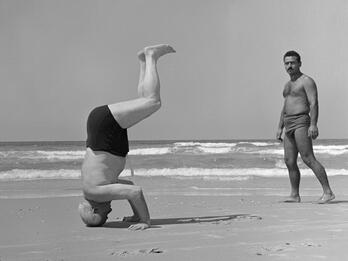Letter to the Art Editor of the New York Times
Adolph Gottlieb
Mark Rothko
1943
June 7, 1943
Mr. Edward Alden Jewell
Art Editor
New York Times
229 West 43 Street
New York, N.Y.
Dear Mr. Jewell:
To the artist, the workings of the critical mind is one of life’s mysteries. That is why, we suppose, the artist’s complaint that he is misunderstood, especially by the critic, has become a noisy commonplace. It is, therefore, an event when…

Related Guide
Destruction, Rebirth, and Cultural Thought
The years between 1939 and 1973 witnessed unprecedented tragedy and transformation for the Jewish people.
Related Guide
Post-Holocaust Jewish Cultural “Spaces”
Postwar Jewish communities created new spaces globally, as American Jews moved to suburbs, Israel established sovereign spaces, and a new European Jewish identity emerged.
Related Guide
The Holocaust: Years of Catastrophe
Jewish writing in Nazi-occupied areas documented ghetto life, moral questions, and Jewish identity, while writers in free zones grappled with the unfolding tragedy.
Creator Bio
Adolph Gottlieb
The avant-garde painter Adolph Gottlieb was born into a Jewish family in New York City. As an art-obsessed teenager, Gottlieb fled to Paris; he learned painting, in part, though daily visits to the Louvre and by haunting museums and galleries all over Europe. In the 1930s, as his career flourished, Gottlieb was horrified by the rise of fascism; as a symbol of his defiance, he changed the spelling of his first name: Adolf became Adolph. Later that decade, Gottlieb demanded that the American Artists’ Congress repudiate Hitler and Stalin. When it did not, he resigned.
Creator Bio
Mark Rothko
The American painter Mark Rothko was born in Dvinsk, Russia, in the Pale of Settlement. Before becoming one of America’s best-known abstract expressionists, he attended Yale University. Rothko grew up speaking Russian, Yiddish, and Hebrew; he was Markus Rotkovich when he attended Jewish school, learning Talmud. When his Orthodox family moved to Portland, Oregon, in 1913, the young Rothko was still engaged in Jewish communal life. As his artistic career flourished, Rothko drifted from Judaism, although some art critics still discern strong Jewish elements in his work.


